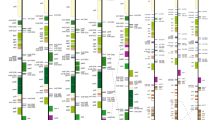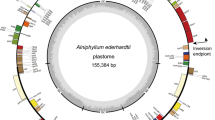Abstract
P-type sieve-element plastids were found in theGunneraceae, while S-type plastids are present in theHaloragaceae andHippuridaceae. The specific characters of the sieve-element plastids (e.g., their size and the morphology of their contents) are discussed in relation to other taxa of theRosidae containing P-type plastids and to the systematic position of theGunneraceae.
Similar content being viewed by others
References
Behnke, H.-D., 1974: P- and S-Typ Siebelement-Plastiden beiRhamnales. — Beitr. Biol. Pfl.50, 457–464.
—— 1977: Transmission electron microscopy and systematics of flowering plants. — Pl. Syst. Evol., Suppl.1, 155–178.
—— 1981: Sieve-element characters. — Nord. J. Bot.1, 381–400.
—— 1982a: Sieve-element plastids, exine sculpturing and the systematic affinities of theBuxaceae. — Pl. Syst. Evol.139, 257–266.
—— 1982b: Sieve-element plastids ofConnaraceae andOxalidaceae. A contribution to the knowledge of P-type plastids in dicotyledons and their significance. — Bot. Jahrb. Syst.103, 1–8.
—— 1982c: Sieve-element plastids ofCyrillaceae, Erythroxylaceae andRhizophoraceae: Description and significance of subtype P V plastids. — Pl. Syst. Evol.141, 31–39.
—— 1985: Contributions to the knowledge of P-type sieve-element plastids in dicotyledons. II.Eucryphiaceae. — Taxon34, 607–610.
——, 1983: New evidence from the ultrastructural and micromorphological fields in angiosperm classification. — Nord. J. Bot.3, 43–66.
——, 1981: Sieve-element plastids and crystalline P(holem)-protein inLeguminosae: Micromorphological characters as an aid to the circumscription of the family and the subfamilies. — InPolhill, R. M., Raven, P. H., (Eds.): Advances in Legume Systematics, pp. 707–715. — London: H.M.S.O.
Bentham, G., Hooker, J. D., 1862: Genera Plantarum.
Cronquist, A., 1968: The Evolution and Classification of Flowering Plants. — London: Nelson.
—— 1981: An Integrated System of Classification of Flowering Plants. — New York: Columbia University Press.
Dahlgren, R. M. T., 1975: A system of classification of the angiosperms to be used to demonstrate the distribution of characters. — Bot. Notiser128, 119–147.
—— 1980: A revised system of classification of the angiosperms. — Bot. J. Linn. Soc.80, 91–124.
——, 1984: The orderMyrtales: Circumscription, variation, and relationships. — Ann. Missouri. Bot. Gard.71, 633–699.
Ehrendorfer, F., 1983:Angiospermae. — InDenffer, D. v. & al., (Eds.): Lehrbuch der Botanik, 32th ed., 796–915. — Stuttgart, New York: Fischer.
Eichler, A. W., 1876: Syllabus der Vorlesungen über Phanerogamenkunde. — Kiel: Schwer’sche Buchhandlung.
—— 1880: Syllabus der Vorlesungen über Phanerogamenkunde. 2nd ed. — Berlin: Borntraeger.
Huber, H., 1963: Die Verwandtschaftsverhältnisse der Rosifloren. — Mitt. Bot. Staatss.5, 1–48.
Hutchinson, J., 1959: The Families of the Flowering Plants. 2nd ed. Vol. I: Dicotyledons. — Oxford: Clarendon Press.
Meissner, C. F., 1836–1843: Plantarum vascularum genera. — Leipzig: Weidmann.
Melchior, H., (Ed.), 1964:A. Engler’s Syllabus der Pflanzenfamilien, 12th ed., II. Band Angiospermen. — Berlin: Borntraeger.
Praglowski, J., 1970: The pollen morphology of theHaloragaceae with reference to taxonomy. — Grana10, 159–239.
Takhtajan, 1959: Die Evolution der Angiospermen. — Jena: VEB Fischer.
—— 1969: Flowering Plants. Origin and Dispersal. — Edinburgh: Oliver & Boyd.
—— 1973: Evolution und Ausbreitung der Blütenpflanzen. — Stuttgart: G. Fischer.
—— 1980: Outline of the classficiation of flowering plants (Magnoliophyta) — Bot. Rev.46, 225–359.
Thorne, R. F., 1968: Synopsis of a putatively phylogenetic classification of the flowering plants. — Aliso6 (4), 57–66.
—— 1976: A phylogenetic classification of the angiospermae. — Evol. Biol.9, 35–106.
—— 1981: Phytochemistry and angiosperm phylogeny. A statement. — InYoung, D. A., Seigler, D. S., (Eds.): Phytochemistry and Angiosperm Phylogeny, pp. 233–295. — New York: Praeger.
Author information
Authors and Affiliations
Additional information
Contributions to the Knowledge of P-Type Sieve-Element Plastids in Dicotyledons, III. — For other parts of this series see (I.:)Behnke (1982 b) and (II.:)Behnke (1985).
Rights and permissions
About this article
Cite this article
Behnke, HD. Contributions to the knowledge of sieve-element plastids inGunneraceae and allied families. Pl Syst Evol 151, 215–222 (1986). https://doi.org/10.1007/BF02430276
Received:
Issue Date:
DOI: https://doi.org/10.1007/BF02430276




